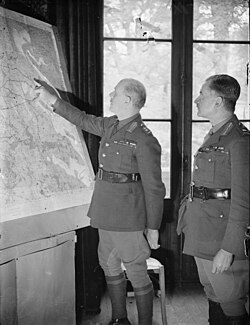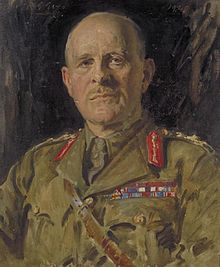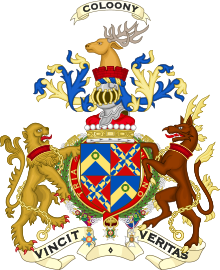|
John Vereker, 6th Viscount Gort
Field Marshal John Standish Surtees Prendergast Vereker, 6th Viscount Gort, VC, GCB, CBE, DSO & Two Bars, MVO, MC (10 July 1886 – 31 March 1946) was a senior British Army officer. As a young officer during the First World War, he was decorated with the Victoria Cross for his actions during the Battle of the Canal du Nord. During the 1930s he served as Chief of the Imperial General Staff (the professional head of the British Army). He is best known for commanding the British Expeditionary Force that was sent to France in the first year of the Second World War, only to be evacuated from Dunkirk the following year. Gort later served as Governor of Gibraltar and Malta, and High Commissioner for Palestine and Transjordan. Early lifeVereker was born in London. His mother was Eleanor, Viscountess Gort née Surtees (1857–1933;[1] later Eleanor Benson),[2] who was a daughter of the writer Robert Smith Surtees. Vereker's father was John Gage Prendergast Vereker, 5th Viscount Gort (1849–1902).[2] J. S. S. P. Vereker grew up in County Durham and the Isle of Wight. He was educated at Malvern Link Preparatory School, Harrow School,[3] and entered the Royal Military College, Sandhurst in January 1904.[4] As Viscount Gort, he was commissioned as a second lieutenant in the Grenadier Guards on 16 August 1905,[5][6] and promoted to lieutenant on 1 April 1907.[6] In November 1908, Gort visited his uncle, Jeffrey Edward Prendergast Vereker, a retired British army major, who was living in Canada, at Kenora, Ontario. During a moose hunting trip, Gort slipped off a large boulder, causing his rifle to discharge; the bullet injured a local guide, William Prettie, who later died of his wound in Winnipeg. Gort returned immediately to England.[7] While studying at Trinity College, Cambridge he was initiated into Isaac Newton University Lodge.[8] Gort commanded the detachment of Grenadier Guards that bore the coffin at the funeral of King Edward VII in May 1910.[6] He was appointed a Member of the Royal Victorian Order in June 1910.[9] First World WarOn 5 August 1914, Gort was promoted to captain.[10] He went to France with the British Expeditionary Force and fought on the Western Front, taking part in the retreat from Mons in August 1914.[11] He became a staff officer with the First Army in December 1914 and then became brigade major of the 4th (Guards) Brigade in April 1915.[11][12] He was awarded the Military Cross in June 1915.[13] Promoted to the brevet rank of major[3] in June 1916, he became a staff officer at the Headquarters of the British Expeditionary Force and fought at the Battle of the Somme throughout the autumn of 1916.[11] He was given the acting rank of lieutenant colonel in April 1917[14] on appointment as Commanding Officer of 4th Battalion, Grenadier Guards and, having been awarded the Distinguished Service Order (DSO) in June 1917,[15] he led his battalion at the Battle of Passchendaele,[11] earning a Bar to his DSO in September 1917.[16] The bar's citation reads:[17]
On 27 November 1918, sixteen days after the war came to an end, Gort was awarded the Victoria Cross, the highest award for gallantry in the face of the enemy that can be awarded to British and Commonwealth forces, for his actions on 27 September 1918 at the Battle of the Canal du Nord, near Flesquieres, France.[18] Victoria Cross citation
Subsequent to this he became known as "Tiger" Gort.[19] He won a second Bar to his DSO in January 1919, with the citation reading:
He was also mentioned in despatches eight times during the war.[11] Inter-war yearsGort was promoted to the substantive rank of major on 21 October 1919.[21] He studied at the Staff College, Camberley, was posted Headquarters London District in 1919 and, having been promoted to brevet lieutenant-colonel on 1 January 1921,[22] he was posted back to the College as an instructor.[11] He left the Staff College in May 1923.[23] Promoted to colonel in April 1926 (with seniority backdated to 1 January 1925),[24] he became a staff officer at London District in 1926 and then became a chief instructor at the Senior Officers' School at Sheerness.[25] After being posted to Shanghai in January 1927, he gave a report of his findings to the King and the Prince of Wales. He returned home to be a staff officer at Headquarters 4th Infantry Division at Colchester in July 1927.[25] In June 1928, Gort was appointed a Commander of the Order of the British Empire.[26] He was appointed commander of the Guards Brigade in 1930, and officer in command of military training in India with the temporary rank of brigadier in 1932.[27] After acquiring a de Havilland Moth aircraft named Henrietta in 1930, Gort became chairman of the Household Brigade Flying Club. On 25 November 1935, he was promoted, at the relatively young age (in peacetime, where promotion was painfully slow) of 49,[28] to major-general.[29] He returned to the Staff College in 1936 as its Commandant.[25][28] In May 1937, Gort was appointed a Companion of the Order of the Bath.[30] In September 1937, he became Military Secretary to the War Minister, Leslie Hore-Belisha, with the temporary rank of lieutenant-general.[31] On 6 December 1937, as part of a purge by Hore-Belisha of senior officers,[32] Gort was appointed to the Army Council,[33] made a general and replaced Field Marshal Sir Cyril Deverell as Chief of the Imperial General Staff (CIGS).[34] On 1 January 1938, he was made a Knight Commander of the Order of the Bath.[35] His appointment was generally well received in the army, although there was some resentment in his having passed over a number of much older and more senior officers, among them John Dill, Archibald Wavell and Alan Brooke, who would later become an outspoken critic of Gort.[28] He was not especially highly regarded for his intelligence and so Major General Ronald Adam was appointed to be Gort's Deputy Chief of the Imperial General Staff.[28] On 2 December 1938 Gort submitted a report on the readiness of the British Army. He observed that Nazi Germany, as a result of the acquisition of Czechoslovakia, was in a stronger position than the previous year and that as a result of the government's decision in 1937 to create a "general purpose" army, Britain lacked the necessary forces for the defence of France.[36] On 21 December Gort recommended to the Chiefs of Staff that Britain would need to help France defend the Netherlands and Belgium,[37] and that for that purpose the British Army needed complete equipment for four Regular army infantry divisions and two mobile armoured divisions, with the Territorial army armed with training equipment and then war equipment for four divisions.[38] In response, the First Sea Lord, Admiral Sir Roger Backhouse, noted that such a commitment would be substantial. Gort also attacked as a fallacy the theory of strategic mobility by the use of seapower because in modern war land transport was faster and cheaper than transport by sea. The experience of David Lloyd George's 1917 Alexandretta project "proved that [maritime side-shows] invariably led to vast commitments out of all proportion to the value of the object attained".[39] If a purely defensive position was taken the Maginot Line would be broken, and the British Army (with anti-aircraft defence) was only getting £277 million out of a total £2,000 million spent on defence.[40] Second World War On the outbreak of the Second World War, Gort was appointed by Prime Minister Neville Chamberlain as the Commander-in-Chief of the British Expeditionary Force (BEF) in France, arriving there on 19 September 1939.[41] Unimpressed by Gort's qualities for command, War Minister Leslie Hore-Belisha described Gort as: "utterly brainless and unable to grasp the simplest problem".[42] Gort dismissed his subordinates' critiques of the Allies' Plan D, including his former friend Alan Brooke's correct prediction that it would allow the Wehrmacht to outflank the Allied forces, as defeatist.[43][44] The Pillbox affair, as it was known, resulted in Hore-Belisha's dismissal.[45] On 25 May 1940, facing overwhelming German forces, Gort decided that he could no longer support the French Army and ordered a retreat by the BEF northwards to the French coast.[46][47] On reaching the coast Gort oversaw the en masse retirement of the BEF back to the British Isles, involving the Battle of Dunkirk and the Dunkirk evacuation, while France was defeated and surrendered to Nazi Germany four weeks later.[48][49] Some historians have argued that, by these actions, Gort saved the BEF,[46] while others believe that he should have continued to attack the German forces.[50] The chaotic rout of the BEF under Gort's command from France convinced Winston Churchill, the newly installed British Prime Minister, that he was undesirable as a field commander, and he was side-lined to non-combatant posts. On his return from France on 1 June 1940 he was appointed an ADC General to George VI. He accompanied Duff Cooper, to Rabat in Morocco, to rally anti-Nazi French cabinet ministers, but was instead temporarily held on his flying boat.[51]  Gort was appointed Inspector of Training and General Officer Commanding the Home Guard in late 1940.[41] He went on trips to Iceland, Orkney and Shetland. He was then appointed Governor of Gibraltar in 1941.[52][53] In 1943, he succeeded Lord Galway as Colonel Commandant of the Honourable Artillery Company, a position he held until his death.[54]  Gort was appointed Governor of Malta in 1942 and led the defence of the island under siege from enemy forces. The Maltese Government presented a Sword of Honour to him for this role. He pushed ahead with extending the airfield into land reclaimed from the sea, against the advice of the British government, but was later thanked by the War Cabinet for his foresight when the airfield proved vital to the British Mediterranean campaign. Gort received his field marshal's baton from the King at Malta on 20 June 1943. Gort was in attendance, along with Generals Dwight D. Eisenhower and Harold Alexander, when Marshal Pietro Badoglio signed the surrender of all Italian forces in Valletta harbour on 29 September 1943.[55] Gort was also present when his son-in-law, Major William Sidney, received the Victoria Cross from General Sir Harold Alexander, Commander-in-Chief (C-in-C) of the Allied Armies in Italy, on 3 March 1944 in Italy.[52]  Gort was appointed High Commissioner for Palestine and Transjordan in late 1944.[52] He served in this office for only one year. In 1945 he nominated William James Fitzgerald, Chief Justice of Palestine, to enquire into the Jewish-Arab conflict in Jerusalem. Chief Justice Fitzgerald issued his report in which he proposed to divide the city into separate Jewish and Arab Quarters.[56] Despite growing tensions in Palestine, Gort strove to cultivate good personal relations with both Jews and Arabs, and was greatly admired and respected by the Jewish and Arab communities.[57]  During his time in Palestine, Gort's health deteriorated, and he was suffering from great pain and discomfort in his abdomen. He was in fact suffering from liver cancer, but the doctors he consulted in London were unable to properly diagnose his condition. Gort ruled Palestine at the time that the Jewish insurgency was beginning. Despite his efforts, he was unable to stem the growing confrontation between the Yishuv (Jewish community) and British authorities. On 5 November 1945, he stepped down as High Commissioner and returned to Britain. Commenting on his departure, The Palestine Post wrote that "No High Commissioner in the twenty-five years of British rule in Palestine enjoyed greater popular trust and none repaid it with greater personal kindness."[57][58] DeathAfter leaving Palestine and returning to England, Gort was admitted to Guy's Hospital in London, where exploratory surgery revealed that he was dying from inoperable liver cancer.[52][57] Already a viscount in the Peerage of Ireland, Gort was created a viscount in the Peerage of the United Kingdom in February 1946. On 31 March 1946, he died in Guy's Hospital at the age of 59 years.[58] As he did not have a surviving son, the Irish Viscountcy of Gort passed to his brother, Standish Vereker, and the British creation became extinct.[52] His body was entombed in the Sidney family vault at St. John the Baptist Church, Penshurst, in the county of Kent.[52] FamilyGort married Corinna Katherine Vereker, his second cousin, on 22 February 1911; the couple had two sons and a daughter,[6] before divorcing (1925).[25] Their elder son, Charles Standish Vereker, was born on 23 February 1912, and served as a lieutenant with the Grenadier Guards, before committing suicide (26 February 1941).[59] A second son, Jocelyn Cecil Vereker, was born on 27 July 1913, but died before his second birthday.[2] Gort's daughter, Jacqueline Corinne Yvonne Vereker, who was born on 20 October 1914, married (June 1940) The Honourable William Sidney, later the 1st Viscount De L'Isle.[2] Portrayals
Arms
References
Bibliography
Further reading
External linksWikimedia Commons has media related to John Vereker, 6th Viscount Gort.
|




